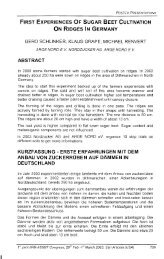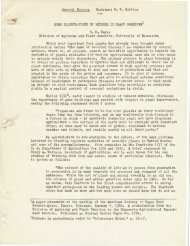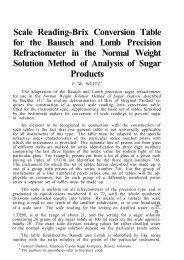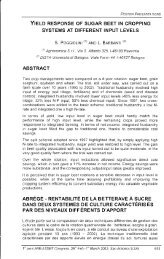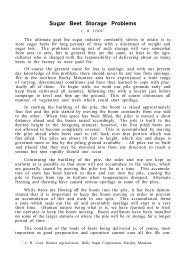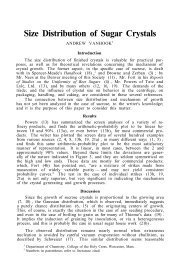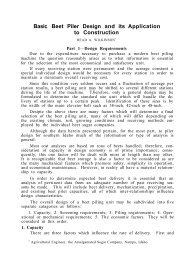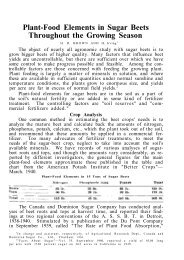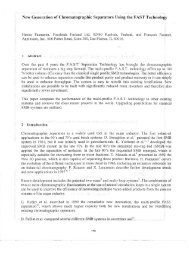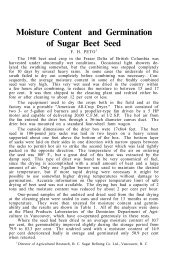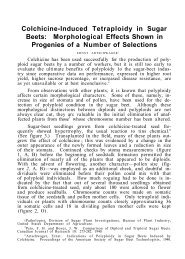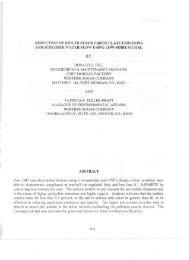membrane filtration of various sugar solutions - ASSBT Proceedings
membrane filtration of various sugar solutions - ASSBT Proceedings
membrane filtration of various sugar solutions - ASSBT Proceedings
Create successful ePaper yourself
Turn your PDF publications into a flip-book with our unique Google optimized e-Paper software.
Membrane Filtration <strong>of</strong> Various Sugar Solutions<br />
Vadim Kochergin<br />
Amalgamated Research Inc.<br />
Twin Falls, Idaho<br />
INTRODUCTION<br />
There are several important reasons for recent breakthrough <strong>of</strong> <strong>membrane</strong> technologies into<br />
most <strong>of</strong>the major industries. Drastic improvement <strong>of</strong><strong>membrane</strong> materials has been made during the<br />
last 10-15 years. New environmental regulations impose additional requirements on conventional<br />
<strong>filtration</strong> processes resulting in increased cost <strong>of</strong>filter cake handling and disposal. Lower costs and<br />
an extended lifetime <strong>of</strong>the <strong>membrane</strong>s are among the factors to be ~entione d in this context. These<br />
and other factors make <strong>membrane</strong> technology applicable in the areas where it was not previously<br />
regarded feasible. Therefore, the time has come to reconsider replacement <strong>of</strong> conventional <strong>filtration</strong><br />
and to develop the new applications for <strong>membrane</strong> separations.<br />
The <strong>sugar</strong> industry is one <strong>of</strong> the few areas that <strong>membrane</strong> "explosion" has not reached. It is<br />
even more surprising taking into account that first research papers on <strong>membrane</strong> applications in <strong>sugar</strong><br />
industry appeared in the early 1970's. R F. Madsen! reported testing UF cellulose acetate <strong>membrane</strong>s<br />
for beet <strong>sugar</strong> juices' purification and RO <strong>membrane</strong>s for juice concentration. An idea <strong>of</strong> replacing<br />
conventional juice purification by <strong>membrane</strong> process fascinated <strong>sugar</strong> technologists for many years.<br />
Numerous efforts have been done to test the feasibility <strong>of</strong> the new processes 2 ,3,4 W. K. Nielsen and<br />
his colleagues gave an extensive review and summary <strong>of</strong> these efforts 5 Variations in juice properties<br />
and analytical procedures shown in the papers <strong>of</strong> different authors make it difficult to conclude<br />
whether or not <strong>membrane</strong>s can replace traditional processes . . Information is available in the literature 6<br />
on use <strong>of</strong><strong>membrane</strong>s for clarification and decolorization <strong>of</strong> cane syrups.<br />
Only recently a large-scale system was installed for ultra<strong>filtration</strong> <strong>of</strong> clarified cane juice. The<br />
system utilizes Kerasep ceramic <strong>membrane</strong>s. Details on system parameters and operation can be<br />
found in the literature 7 ,8.<br />
The purpose <strong>of</strong>this paper is to review possible applications for <strong>membrane</strong> technology in the<br />
<strong>sugar</strong> industry based on the analysis <strong>of</strong> <strong>sugar</strong> processing technology and recent experimental results.<br />
Applications where micro- or ultra<strong>filtration</strong> processes are used as a pretreatment <strong>of</strong> feed to<br />
chromatographic separation will be discussed.<br />
PotentiaJ applications for <strong>membrane</strong> technology<br />
Most <strong>of</strong> the applications in the <strong>sugar</strong> industry would impose specific requirements on<br />
<strong>membrane</strong> characteristics:<br />
1. High fluxes (a typical <strong>sugar</strong> plant produces 1000-2000 gpm <strong>of</strong> juice).<br />
360



